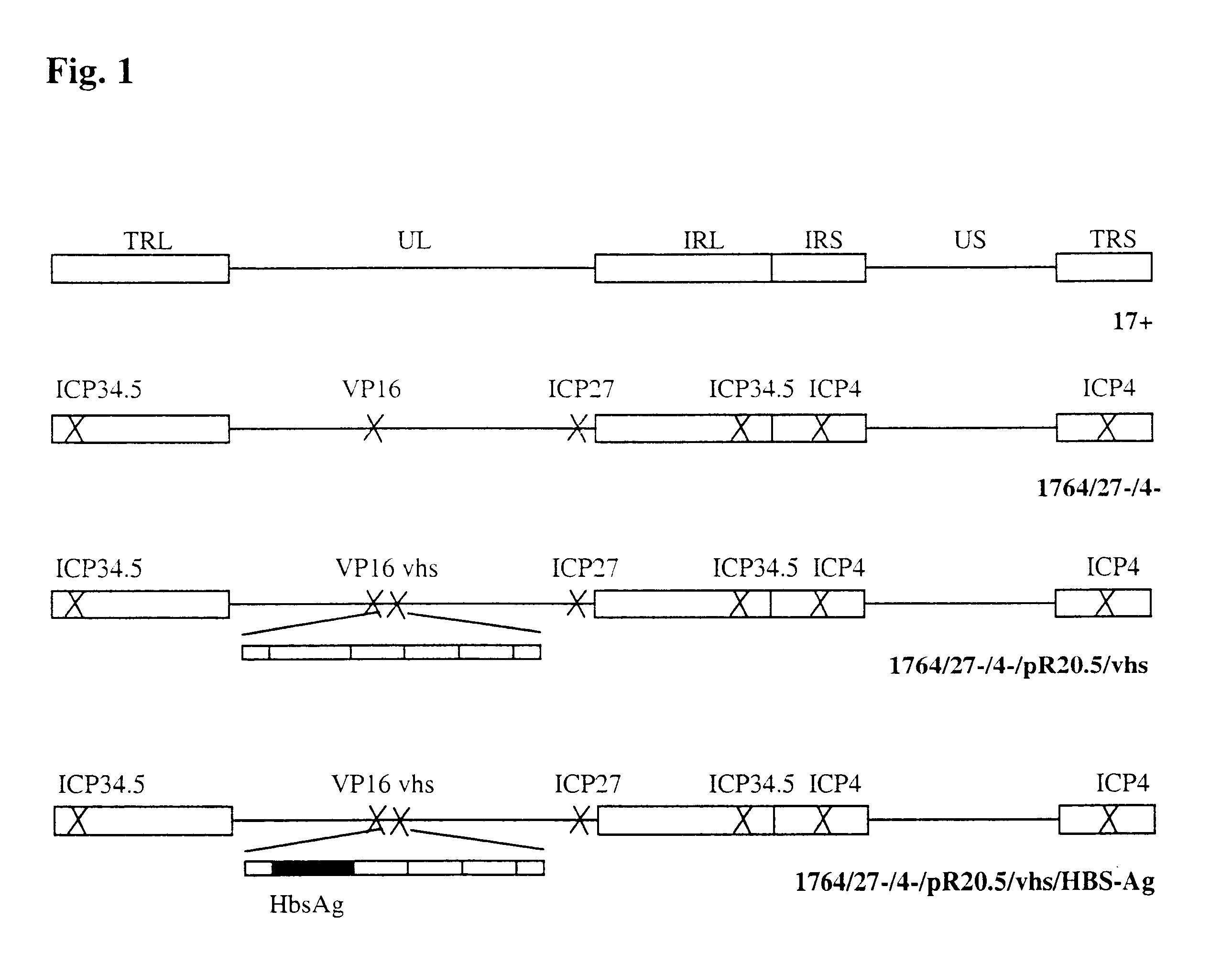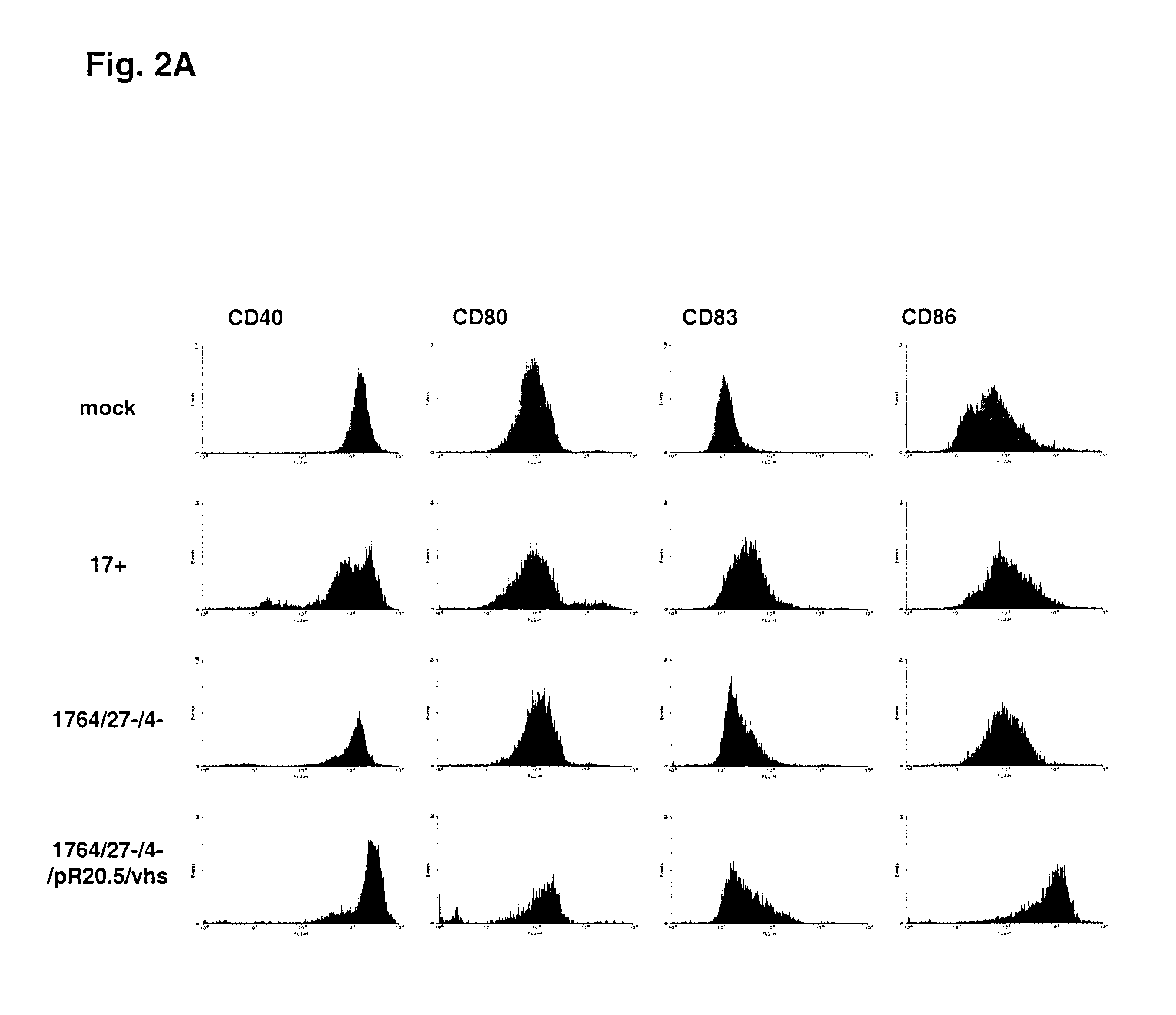Herpes viruses for immune modulation
a technology of herpes virus and immune modulation, applied in the direction of viruses, reverse transcribing dna viruses, drug compositions, etc., can solve the problems of hampered approach, retroviruses do not give high-efficiency gene delivery, and lack of efficient means
- Summary
- Abstract
- Description
- Claims
- Application Information
AI Technical Summary
Benefits of technology
Problems solved by technology
Method used
Image
Examples
example 1
Preliminary Data Showing That HSV Strains not Containing a Functional vhs Gene Give Enhanced Activation of Dendritic Cells Following Virus Infection.
Here in each case 1.times.10.sup.5 dendritic cells were infected with each of the viruses by gentle pelleting, resuspension in about 100 .mu.l virus suspension in DMEM, incubation at 37.degree. C. for 1 hr, and transfer into 24 well plates with 2 ml of RPMI / 10%FCS +100 ng / ml GM-CSF, 50 ng / ml IL-4. These plates were then incubated at 37.degree. C. / 5% CO.sub.2 overnight. Dendritic cells were also treated with lipopolysaccharide (LPS) a known dendritic cell activator, and untreated as a controls.
Supernatants from these infections and from the control were then used in ELISA tests to detect levels of secreted cytokines. Fluorescence activated cell sorting (FACS) was also used to detect levels of expression of CD86 on the surface of infected and control dendritic cells. In dendritic cell cultures there are two populations of cells with respe...
example 2
HSV Strains not Containing a Functional vhs Protein do not Block Dendritic Cell Activation
Fluorescence activated cell sorting (FACS) was used to detect levels of expression of CD86, CDSO, CD83 and CD40 on the surface of infected and control dendritic cells. Supernatants from the infections was used to assess levels of cytokines by ELISA.
Results
The ELISA results (FIG. 3) show that while DC can be infected with HSV at high efficiency, cytokines indicative of DC activation are not produced with either a wild type (strain 17+) or a disabled (strain 1764 / 27- / 4-) virus. However if vhs is inactivated from strain 1764 / 27- / 4- , giving strain 1764 / 27- / 4- / pR20.5 / vhs, cytokines indicative of DC activation are then produced.FACS analysis (FIG. 2) on non-LPS stimulated DC shows that infection with essentially wild type HSV (strain 17+) or a replication incompetent HSV vector (strain 1764 / 27- / 4-) prevents the increased expression of CD86. As discussed above, increased CD86 expression would be expe...
example 3
DC Transduced with a vhs Inactivated HSV Vector Direct Antigen Specific T Cell Responses in Vitro.
The results above suggested that HSV vectors in which vhs is inactivated might be used as effective vectors for DC as the inactivating effects of HSV in DC have been prevented. Indeed DC infected with such HSV mutants appear to be specifically activated in response to infection as measured by CD86 up-regulation and the secretion of certain cytokines. To test whether vhs-inactivated HSV mutants might be used to direct antigen specific immune responses following the delivery of antigen encoding genes to DC, experiments were performed using DC and T-cells prepared from hepatitis B vaccinated and un-vaccinated individuals. Here a virus was first constructed in which a hepatitis B surface antigen (HBS-Ag) expression cassette was inserted into the vhs encoding gene of the IE gene deficient virus. T-cell proliferation assays were then performed in which DC from vaccinated or un-vaccinated indi...
PUM
| Property | Measurement | Unit |
|---|---|---|
| molecular weight | aaaaa | aaaaa |
| surface | aaaaa | aaaaa |
| nucleic acid sequence homology | aaaaa | aaaaa |
Abstract
Description
Claims
Application Information
 Login to View More
Login to View More - R&D
- Intellectual Property
- Life Sciences
- Materials
- Tech Scout
- Unparalleled Data Quality
- Higher Quality Content
- 60% Fewer Hallucinations
Browse by: Latest US Patents, China's latest patents, Technical Efficacy Thesaurus, Application Domain, Technology Topic, Popular Technical Reports.
© 2025 PatSnap. All rights reserved.Legal|Privacy policy|Modern Slavery Act Transparency Statement|Sitemap|About US| Contact US: help@patsnap.com



